Impact of Care and Nutrition Methods on the Content and Uptake of Selected Mineral Elements in Solanum tuberosum
Abstract
1. Introduction
2. Materials and Methods
2.1. Plant Growth Conditions and Experimental Design
2.2. Chemical Analysis Methods
2.3. Statistical Analysis
2.4. Meteorological Conditions
3. Results and Discussion
3.1. Content and Uptake of Phosphorus in Potato Tubers
3.2. Content and Uptake of Calcium in Potato Tubers
3.3. Content and Uptake of Magnesium in Potato Tubers
3.4. Content and Uptake of Potassium in Potato Tubers
4. Conclusions
Author Contributions
Funding
Data Availability Statement
Conflicts of Interest
References
- Burlingame, B.; Mouillé, B.; Charrondière, R. Nutrients, bioactive non-nutrients and anti-nutrients in potatoes. J. Food Compos. Anal. 2009, 22, 494–502. [Google Scholar] [CrossRef]
- Ezekiel, R.; Singh, N.; Sharma, S.; Kaur, A. Beneficial phytochemicals in potato—A review. Food Res. Int. 2013, 50, 487–496. [Google Scholar] [CrossRef]
- Lombardo, S.; Pandino, G.; Mauromicale, G. Optimizing Nitrogen Fertilization to Improve Qualitative Performances and Physiological and Yield Responses of Potato (Solanum tuberosum L.). Agronomy 2020, 10, 352. [Google Scholar] [CrossRef]
- Silveira, A.C.; Orena, S.; Medel-Maraboli, M.; Escalona, V.H. Determination of some functional and sensory attributes and suitability of colored- and noncolored-flesh potatoes for different cooking methods. Food Sci. Technol. 2020, 40 (Suppl. S2), 395–404. [Google Scholar] [CrossRef]
- Manjunath, R.P.; Vishnuvardhana; Anjanappa, M.; Ramegowda, G.K.; Anilkumar, S.; Prasad, P.S. Influence of Foliar Spray of Micronutrient Formulation on Quality and Shelf Life of Potato (Solanum tuberosum L.). Int. J. Pure Appl. Biosci. 2018, 6, 660–665. [Google Scholar] [CrossRef]
- Trawczyński, C. The effect of foliar preparation with silicon on the yield and quality of potato tubers in compared to selected biostimulators. Fragm. Agron. 2018, 35, 113–122. [Google Scholar] [CrossRef]
- Lombardo, S.; Lo Monaco, A.; Pandino, G.; Parisi, B.; Mauromicale, G. The phenology, yield and tuber composition of ‘early’ crop potatoes: A comparison between organic and conventional cultivation systems. Renew. Agric. Food Syst. 2013, 28, 50–58. [Google Scholar] [CrossRef]
- Zarzecka, K.; Gugała, M.; Mystkowska, I. Effect of agricultural treatments on the content of total and protein nitrogen in potato tubers. Ecol. Chem. Eng. A 2009, 16, 1–6. [Google Scholar]
- Rutkowska, A. Biostimulators in modern plant cultivation. Studia i Raporty IUNG-PIB 2016, 48, 65–80. (In Polish) [Google Scholar] [CrossRef]
- Yakhin, O.I.; Lubyanov, A.A.; Yakhin, I.A.; Brown, P.H. Biostimulants in Plant Science: A Global Perspective. Front. Plant Sci. 2017, 7, 2049. [Google Scholar] [CrossRef]
- Shekari, G.; Javanmardi, J. Application of cysteine, methionine and amino acid containing fertilizers to replace urea: The effects on yield and quality of Broccoli. Adv. Crop. Sci. Tech. 2017, 5, 283. [Google Scholar] [CrossRef]
- Głosek-Sobieraj, M.; Cwalina-Ambroziak, B.; Wierzbowska, J.; Waśkiewicz, A. The Influence of Biostimulants on the Content of P, K, Ca, Mg, and Na in the Skin and Flesh of Potato Tubers. Pol. J. Environ. Stud. 2019, 28, 1–8. [Google Scholar] [CrossRef]
- Mystkowska, I.; Rogóż-Matyszczak, A. Content and Uptake of Selected Microelements with Potato Tuber Yield Treated with Biostimulators. J. Ecol. Eng. 2019, 20, 65–70. [Google Scholar] [CrossRef]
- Zarzecka, K.; Mystkowska, I.; Gugała, M.; Dołęga, H. Content and uptake of selected macroelements with the yield of potato tubers depending on herbicides and biostimulants. J. Elem. 2019, 24, 165–179. [Google Scholar] [CrossRef]
- Piotrowski, K.; Romanowska-Duda, Z. Positive impact of bio-stimulators on growth and physiological activity of willow in climate change conditions. Int. Agrophys. 2018, 32, 279–286. [Google Scholar] [CrossRef]
- Wadas, W.; Dziugieł, T. Changes in Assimilation Area and Chlorophyll Content of Very Early Potato (Solanum tuberosum L.) Cultivars as Influenced by Biostimulants. Agronomy 2020, 10, 387. [Google Scholar] [CrossRef]
- Cwalina-Ambroziak, B.; Głosek-Sobieraj, M.; Kowalska, E. The effect of plant growth regulators on the incidence and severity of potato diseases. Pol. J. Nat. Sci. 2015, 30, 5–20. [Google Scholar]
- Zarzecka, K.; Gugała, M.; Sikorska, A.; Grzywacz, K.; Niewęgłowski, M. Marketable Yield of Potato and Its Quantitative Parameters after Application of Herbicides and Biostimulants. Agriculture 2020, 10, 49. [Google Scholar] [CrossRef]
- Merga, B.; Dechassa, N. Growth and productivity of different potato cultivars. J. Agric. Sci. 2019, 11, 528–534. [Google Scholar] [CrossRef]
- Rouphael, Y.; Colla, G. Editorial: Biostimulants in Agriculture. Front. Plant Sci. 2020, 11, 40. [Google Scholar] [CrossRef]
- Colla, G.; Rouphael, Y. Biostimulants in horticulture. Sci. Hortic. 2015, 196, 1–2. [Google Scholar] [CrossRef]
- du Jardin, P. Plant biostimulants: Definition, concept, main categories and regulation. Sci. Hortic. 2015, 196, 3–14. [Google Scholar] [CrossRef]
- Petropoulos, S.A.; Taofiq, O.; Fernandes, Â.; Tzortzakis, N.; Ciric, A.; Sokovic, M.; Barros, L.; Ferreira, I.C. Bioactive properties of greenhouse-cultivated green beans (Phaseolus vulgaris L.) under biostimulants and water-stress effect. J. Sci. Food Agric. 2019, 99, 6049–6059. [Google Scholar] [CrossRef] [PubMed]
- Petropoulos, S.A.; Fernandes, Â.; Plexida, S.; Chrysargyris, A.; Tzortzakis, N.; Barreira, J.C.M.; Barros, L.; Ferreira, I.C.F.R. Biostimulants Application Alleviates Water Stress Effects on Yield and Chemical Composition of Greenhouse Green Bean (Phaseolus vulgaris L.). Agronomy 2020, 10, 181. [Google Scholar] [CrossRef]
- Pereira, C.; Dias, M.I.; Petropoulos, S.A.; Plexida, S.; Chrysargyris, A.; Tzortzakis, N.; Calhelha, R.C.; Ivanov, M.; Stojković, D.; Soković, M.; et al. The Effects of Biostimulants, Biofertilizers and Water-Stress on Nutritional Value and Chemical Composition of Two Spinach Genotypes (Spinacia oleracea L.). Molecules 2019, 24, 4494. [Google Scholar] [CrossRef] [PubMed]
- Koch, M.; Naumann, M.; Pawelzik, E.; Gransee, A.; Thiel, H. The importance of nutrient management for potato production. Part, I. Plant nutrition and yield. Potato Res. 2020, 63, 97–119. [Google Scholar] [CrossRef]
- Jasim, A.H.; Merhij, M.Y. Effect of foliar fertilization on yield of some potato varieties. Euphrates J. Agric. Sci. 2018, 10, 191–198. [Google Scholar]
- Roztropowicz, S. Methodology of Observation, Measurements and Sampling in Agricultural Experiments with Potatoes; Plant Breeding and Acclimatization Institute: Section Jadwisin, Poland, 1999; pp. 1–50. (In Polish) [Google Scholar]
- Koronacki, J. Statistics, for Students of Technical and Natural Sciences; WNT: Warsaw, Poland, 2009; p. 491. ISBN 83-204-2994-3. [Google Scholar]
- Skowera, B.; Jędrszczyk, E.S.; Kopcińska, J.; Ambroszczyk, A.M.; Kołton, A. The Effects of Hydrothermal Conditions during Vegetation Period on Fruit Quality of Processing Tomatoes. Pol. J. Environ. Stud. 2014, 23, 195–202. [Google Scholar]
- Leszczyński, W.; Lisińska, G. Effect of herbicides on chemical composition of potato tubers and quality of the subsequent chips and starch. Starch Stärke 1985, 37, 329–334. [Google Scholar] [CrossRef]
- Wierzbicka, A. Content of minerals in potato tubers grown in the ecological system, their nutritional value and mutual relations. J. Res. Appl. Agric. Eng. 2012, 57, 188–192. [Google Scholar]
- Gugała, M.; Zarzecka, K.; Baranowska, A.; Dołęga, H.; Sikorska, A. The influence of selected agrotechnical factors on the potassium content and its removal by potato tubers. Bothalia 2015, 45, 178–184. [Google Scholar]
- Wierzbowska, J.; Cwalina-Ambroziak, B.; Głosek-Sobieraj, M.; Sienkiewicz, S. Content of minerals in tubers of potato plants treated with bioregulators. Rom. Agric. Res. 2016, 33, 291–298. [Google Scholar]
- Bienia, B.; Sawicka, B.; Krochmal-Marczak, B. Content of macroelements in tubers of several potato varieties depending on the foliar fertilization applied. J. Elem. 2021, 26, 211–224. [Google Scholar] [CrossRef]
- Zarzecka, K.; Gugała, M.; Ginter, A.; Mystkowska, I.; Sikorska, A. The Positive Effects of Mechanical and Chemical Treatments with the Application of Biostimulants in the Cultivation of Solanum tuberosum L. Agriculture 2023, 13, 45. [Google Scholar] [CrossRef]
- Elfaki, A.E.; Abbsher, A.M. Nutritional situation of potato subjected to Sudanese cooking methods. J. Appl. Sci. Res. 2010, 6, 880–924. [Google Scholar]
- Mahamud, M.A.; Chowdhury, M.A.H.; Rahim, M.A.; Mohiuddin, K.M. Mineral nutrient contents of some potato accessions of USA and Bangladesh. J. Bangladesh Agril. Univ. 2015, 13, 207–214. [Google Scholar] [CrossRef]
- Żołnowski, A.C. Studies on variability in yield and quality of edible potato (Solanum tuberosum L.) under conditions of differentiated mineral fertilization. UWM Olszt. Diss. Monogr. 2013, 191, 1–259. [Google Scholar]
- White, P.J.; Bradshaw, J.E.; Dale, M.F.B.; Ramsay, G.; Hammond, J.P.; Warwick, H.R.I.; Broadley, M.R. Relationships between yield and mineral concentrations in potato tubers. HortScience 2009, 44, 6–11. [Google Scholar] [CrossRef]
- Nazir, A.; Bhat, M.A.; Bhat, T.A.; Fayaz, S.; Mir, M.S.; Basu, U.; Ahanger, S.A.; Altaf, S.; Jan, B.; Lone, B.A.; et al. Comparative Analysis of Rice and Weeds and Their Nutrient Partitioning under Various Establishment Methods and Weed Management Practices in Temperate Environment. Agronomia 2022, 12, 816. [Google Scholar] [CrossRef]
- Nassar, A.M.; Sabally, K.; Kubow, S.; Leclerc, Y.N.; Donnelly, D.J. Some Canadian-grown potato cultivars contribute to a substantial content of essential dietary minerals. J. Agric. Food Chem. 2012, 60, 4688–4696. [Google Scholar] [CrossRef] [PubMed]
- Van Niekerk, C.; Schönfeldt, H.; Hall, N.; Pretorius, B. The role of biodiversity in food security and nutrition: A potato cultivar case study. Food Nutr. Sci. 2016, 7, 371. [Google Scholar] [CrossRef]
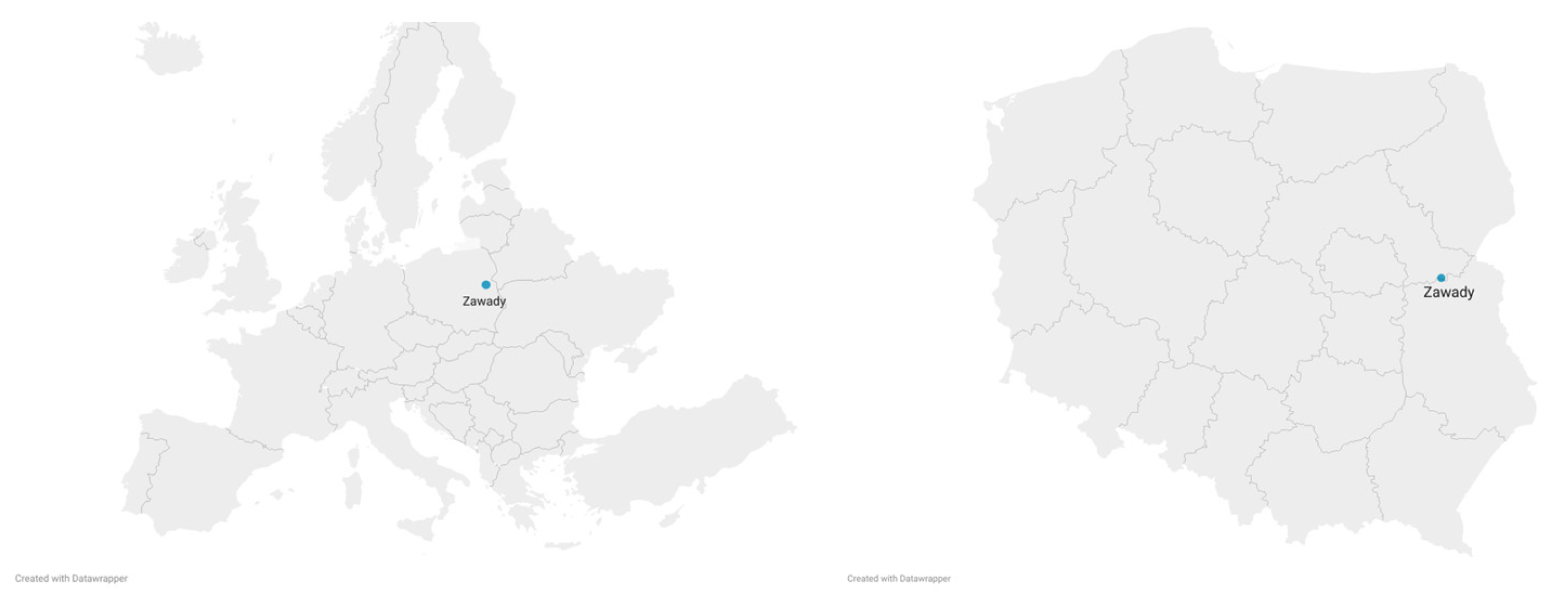
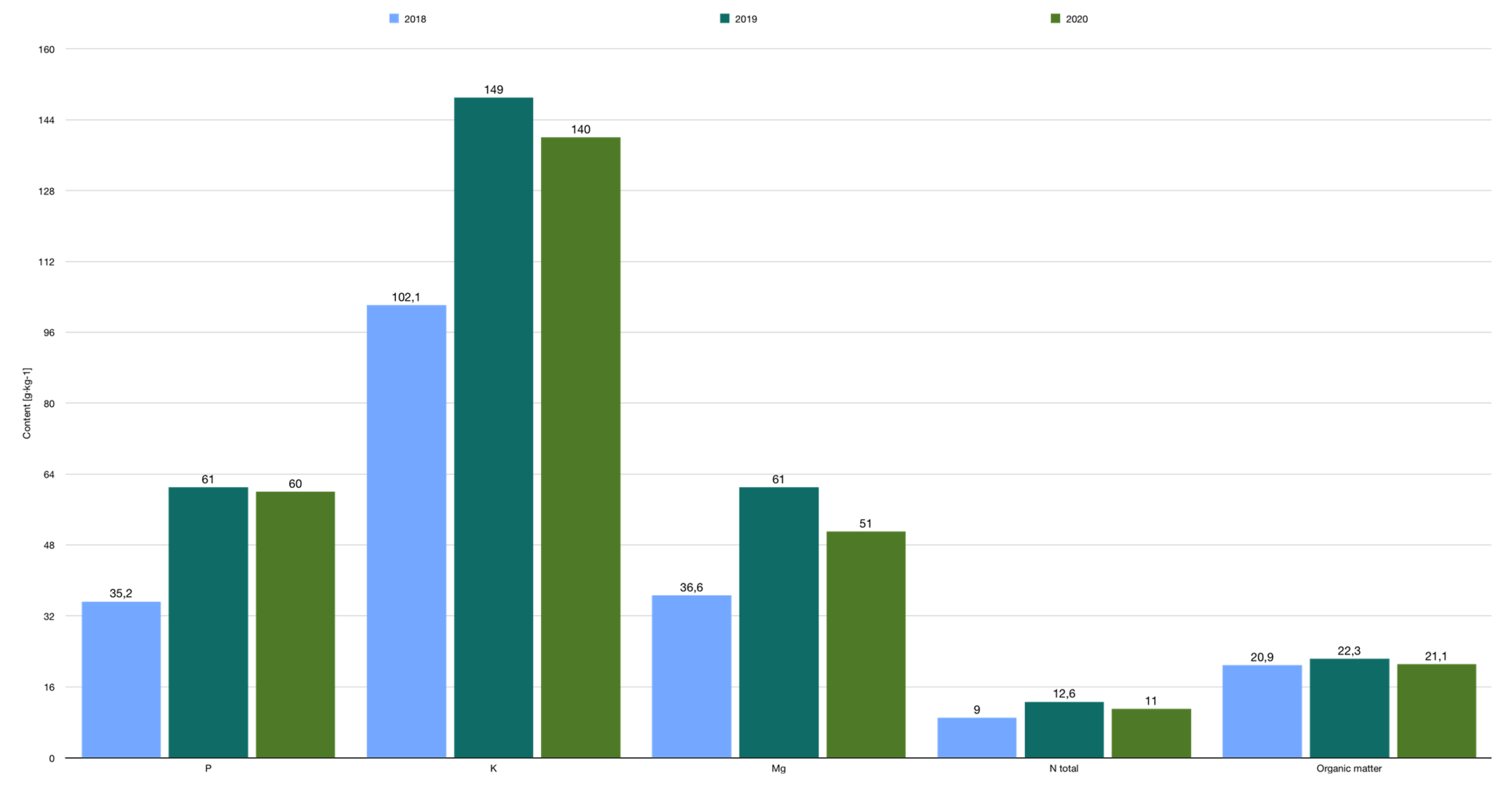
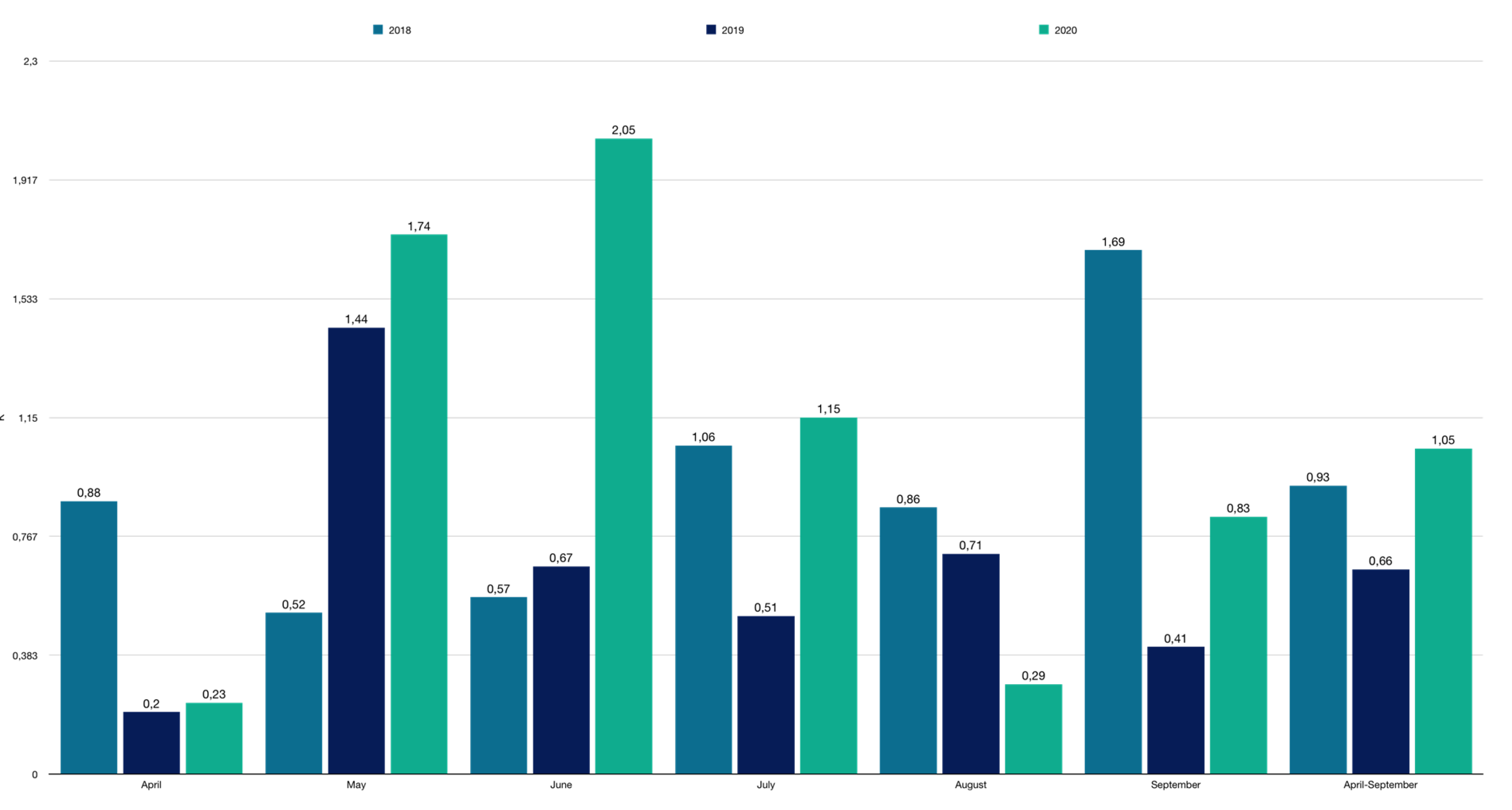
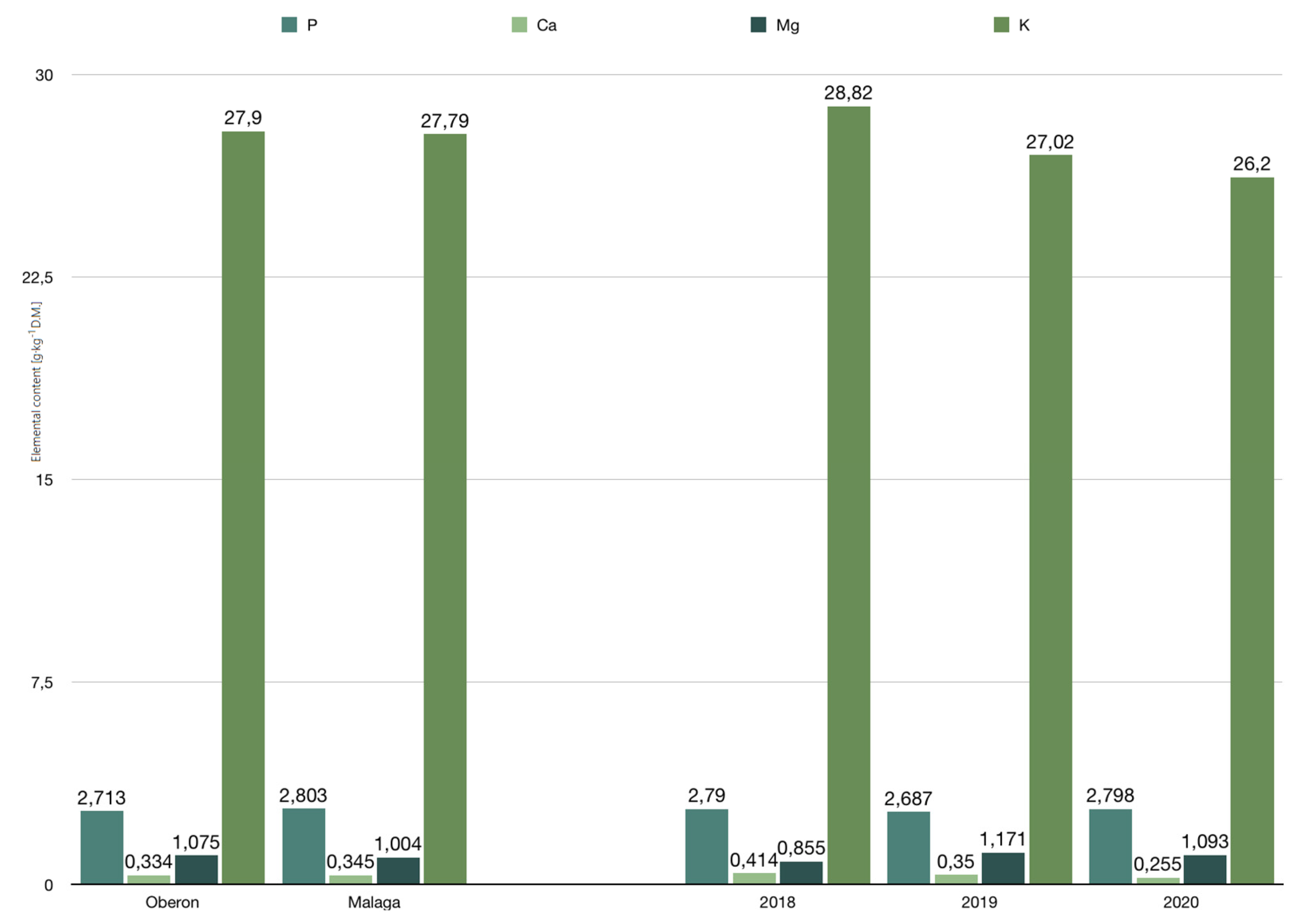
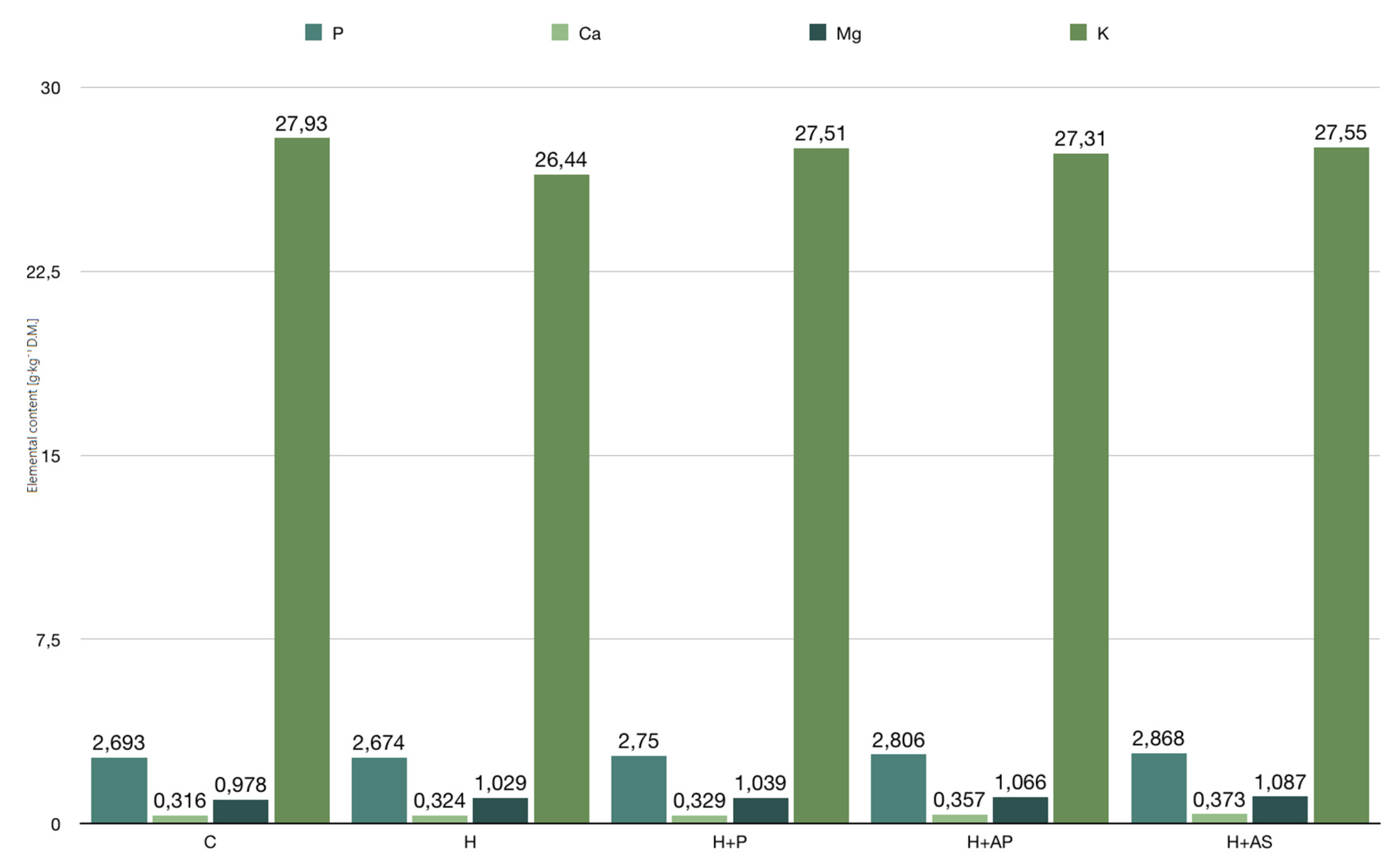
| No. | Active Substance/Composition | Dose Preparation | Usage |
|---|---|---|---|
| 1 | * C object mechanical weeding—no preparations were used | ||
| 2 | ** H | 1.5 dm3 ha−1 | 7–10 days following tuber planting |
| 3 | *** H + P (Ntotal—16.4,%, K2O—0.75%, CaO—0.07%, MgO—0.02%, S—941 mg kg−1, lactic acid bacteria, actinomycetes) | 1.5 dm3 ha−1 and 2.0 dm3 ha−1 | herbicide—7–10 days following tuber planting biostimulator twice—end of emergence and rows closure |
| 4 | **** H + AP (Ntotal—9.48%, Norganic—9.2%, N-NH4—0.88%, Corganic—25%, free amino acids—11.57%, organic matter—87.7%) | 1.5 dm3 ha−1 and 1.5 dm3 ha−1 | just before plants emergence |
| 5 | ***** H + ASF (Ntotal—2.2%, B—0.02%, Mn—0.05%, Zn—0.09%, total amino acids—13.11%, free amino acids—10.66%) | 1.5 dm3 ha−1 and 4.0 dm3 ha−1 | herbicide—just before plants emergence biostimulator twice—end of emergence and rows closure |
| Agrotechnical Treatments | Specification | Dates |
|---|---|---|
| Fertilization | 25 t ha−1 farmyard manure and mineral fertilizers: 44.0 kg ha−1 P (46% TSP triple superphosphate), 124.5 kg ha−1 K (60% potash salt), and 100 kg ha−1 N (34% ammonium salt) | autumn, spring—before planting |
| Planting of potato tubers | spacing 0.675 × 0.37 m | the third week of April |
| Weed control | mechanical weeding and herbicides with biostimulants | after planting to rows closure |
| Colorado potato beetle control | insecticides: thiamethoxam * at a dose of 0.08 kg ha−1, deltamethrin at a dose of 0.15 dm3 ha−1, lambdacyhalothrin at a dose of 0.25 dm3 ha−1, thiacloprid * and deltamethrin at a dose of 0.4 dm3 ha−1 | during vegetation |
| Late blight control | fungicides: metalaxyl-M + mancozeb * at a dose of 2.0 kg ha−1 and mancozeb * at a dose of 2.5 kg ha−1 | during vegetation |
| Harvesting of potato tubers | physiological maturity | first week of September |
| Variant | Years | Mean | ||
|---|---|---|---|---|
| 2018 | 2019 | 2020 | ||
| Oberon | ||||
| 1. C | 2.644 | 2.641 | 2.650 | 2.645 |
| 2. H | 2.618 | 2.640 | 2.642 | 2.633 |
| 3. H + P | 2.685 | 2.653 | 2.718 | 2.685 |
| 4. H + AP | 2.836 | 2.648 | 2.819 | 2.768 |
| 5. H + AS | 2.899 | 2.698 | 2.902 | 2.833 |
| Mean | 2.736 | 2.656 | 2.746 | 2.713 |
| Malaga | ||||
| 1. C | 2.783 | 2.653 | 2.787 | 2.741 |
| 2. H | 2.750 | 2.642 | 2.753 | 2.715 |
| 3. H + P | 2.871 | 2.682 | 2.888 | 2.814 |
| 4. H + AP | 2.900 | 2.727 | 2.903 | 2.843 |
| 5. H + AS | 2.911 | 2.879 | 2.920 | 2.903 |
| Mean | 2.843 | 2.717 | 2.850 | 2.803 |
| Mean for varieties | ||||
| 1. C | 2.714 | 2.647 | 2.719 | 2.693 a |
| 2. H | 2.684 | 2.641 | 2.698 | 2.674 a |
| 3. H + P | 2.778 | 2.668 | 2.803 | 2.750 a |
| 4. H + AP | 2.868 | 2.789 | 2.861 | 2.806 a |
| 5. H + AS | 2.905 | 2.789 | 2.911 | 2.868 a |
| Mean | 2.790 | 2.687 | 2.798 | 2.758 |
| Variant | Years | Mean | ||
|---|---|---|---|---|
| 2018 | 2019 | 2020 | ||
| Oberon | ||||
| 1. C | 23.86 A | 18.24 A | 15.80 A | 19.30 c |
| 2. H | 25.26 A | 19.85 A | 16.43 A | 20.51 c |
| 3. H + P | 26.87 A | 23.25 A | 20.57 A | 23.56 b |
| 4. H + AP | 27.95 A | 22.48 A | 19.14 A | 23.19 b |
| 5. H + AS | 29.98 A | 24.78 A | 25.84 A | 26.87 a |
| Mean | 26.78 | 21.72 | 19.56 | 22.69 |
| Malaga | ||||
| 1. C | 14.22 A | 12.58 A | 14.61 A | 13.80 c |
| 2. H | 15.37 A | 18.09 A | 15.19 A | 16.22 b |
| 3. H + P | 16.50 A | 19.29 A | 17.96 A | 17.92 b |
| 4. H + AP | 16.37 A | 18.56 A | 17.44 A | 17.46 b |
| 5. H + AS | 17.81 A | 21.72 A | 21.76 A | 20.43 a |
| Mean | 16.05 | 18.05 | 17.39 | 17.16 |
| Mean for varieties | ||||
| 1. C | 19.04 | 15.41 | 15.21 | 16.55 c |
| 2. H | 20.32 | 18.97 | 15.81 | 18.37 c |
| 3. H + P | 21.69 | 21.27 | 19.27 | 20.74 b |
| 4. H + AP | 22.16 | 20.52 | 18.29 | 20.32 b |
| 5. H + AS | 23.90 | 23.25 | 23.80 | 23.65 a |
| Mean | 21.24 | 19.89 | 18.48 | 19.87 |
| Variant | Years | Mean | ||
|---|---|---|---|---|
| 2018 | 2019 | 2020 | ||
| Oberon | ||||
| 1. C | 0.385 | 0.325 | 0.223 | 0.311 |
| 2. H | 0.388 | 0.327 | 0.234 | 0.316 |
| 3. H + P | 0.391 | 0.331 | 0.243 | 0.322 |
| 4. H + AP | 0.437 | 0.335 | 0.264 | 0.345 |
| 5. H + AS | 0.447 | 0.379 | 0.281 | 0.369 |
| Mean | 0.410 | 0.343 | 0.249 | 0.334 |
| Malaga | ||||
| 1. C | 0.389 | 0.331 | 0.243 | 0.321 |
| 2. H | 0.390 | 0.346 | 0.256 | 0.331 |
| 3. H + P | 0.393 | 0.352 | 0.260 | 0.335 |
| 4. H + AP | 0.454 | 0.371 | 0.260 | 0.362 |
| 5. H + AS | 0.460 | 0.386 | 0.283 | 0.376 |
| Mean | 0.417 | 0.357 | 0.260 | 0.345 |
| Mean for varieties | ||||
| 1. C | 0.387 | 0.328 | 0.233 | 0.316 |
| 2. H | 0.389 | 0.337 | 0.245 | 0.324 |
| 3. H + P | 0.392 | 0.342 | 0.252 | 0.329 |
| 4. H + AP | 0.446 | 0.363 | 0.262 | 0.357 |
| 5. H + AS | 0.454 | 0.383 | 0.282 | 0.373 |
| Mean | 0.414 a | 0.350 b | 0.255 c | 0.340 |
| Variant | Years | Mean | ||
|---|---|---|---|---|
| 2018 | 2019 | 2020 | ||
| Oberon | ||||
| 1. C | 3.44 A | 2.24 B | 1.33 B | 2.34 c |
| 2. H | 3.75 A | 2.47 B | 1.45 C | 2.56 c |
| 3. H + P | 3.91 A | 2.91 B | 1.87 C | 2.90 b |
| 4. H + AP | 4.30 A | 3.01 B | 1.78 C | 3.03 b |
| 5. H + AS | 4.60 A | 3.50 B | 2.48 C | 3.53 a |
| Mean | 4.00 a | 2.83 b | 1.78 c | 2.87 |
| Malaga | ||||
| 1. C | 2.00 A | 1.56 A | 1.28 A | 1.61 c |
| 2. H | 2.19 A | 2.37 A | 1.40 B | 1.99 b |
| 3. H + P | 2.24 A | 2.54 A | 1.62 B | 2.13 b |
| 4. H + AP | 2.57 A | 2.52 A | 1.58 B | 2.22 b |
| 5. H + AS | 2.80 A | 2.92 A | 2.11 B | 2.61 a |
| Mean | 2.36 a | 2.38 a | 1.60 b | 2.11 |
| Mean for varieties | ||||
| 1. C | 2.72 | 1.90 | 1.31 | 1.98 b |
| 2. H | 2.97 | 2.42 | 1.43 | 2.27 b |
| 3. H + P | 3.07 | 2.72 | 1.75 | 2.52 b |
| 4. H + AP | 3.44 | 2.77 | 1.68 | 2.63 b |
| 5. H + AS | 3.70 | 3.21 | 2.30 | 3.07 a |
| Mean | 3.18 a | 2.60 b | 1.69 c | 2.49 |
| Variant | Years | Mean | ||
|---|---|---|---|---|
| 2018 | 2019 | 2020 | ||
| Oberon | ||||
| 1. C | 0.846 A | 1.155 B | 1.129 A | 1.043 a |
| 2. H | 0.857 A | 1.186 B | 1.147 A | 1.063 a |
| 3. H + P | 0.879 A | 1.195 B | 1.151 A | 1.075 a |
| 4. H + AP | 0.880 A | 1.212 B | 1.161 A | 1.084 a |
| 5. H + AS | 0.893 A | 1.258 A | 1.174 A | 1.108 a |
| Mean | 0.871 | 1.201 | 1.152 | 1.075 |
| Malaga | ||||
| 1. C | 0.822 A | 0.983 B | 0.931 C | 0.912 b |
| 2. H | 0.827 A | 1.154 A | 1.005 B | 0.995 b |
| 3. H + P | 0.832 A | 1.163 A | 1.013 B | 1.003 b |
| 4. H + AP | 0.850 A | 1.193 A | 1.098 A | 1.047 a |
| 5. H + AS | 0.859 A | 1.214 A | 1.125 A | 1.066 a |
| Mean | 0.838 | 1.141 | 1.034 | 1.004 |
| Mean for varieties | ||||
| 1. C | 0.834 | 1.069 | 1.030 | 0.978 b |
| 2. H | 0.842 | 1.170 | 1.076 | 1.029 a |
| 3. H + P | 0.856 | 1.179 | 1.082 | 1.039 a |
| 4. H + AP | 0.865 | 1.203 | 1.130 | 1.066 a |
| 5. H + AS | 0.876 | 1.236 | 1.150 | 1.087 a |
| Mean | 0.855 c | 1.171 a | 1.093 b | 1.040 |
| Variant | Years | Mean | ||
|---|---|---|---|---|
| 2018 | 2019 | 2020 | ||
| Oberon | ||||
| 1. C | 7.65 A | 7.99 A | 6.73 A | 7.46 e |
| 2. H | 8.28 A | 9.00 A | 7.13 A | 8.14 d |
| 3. H + P | 8.74 B | 11.69 A | 8.82 B | 9.75 b |
| 4. H + AP | 8.68 B | 10.27 A | 7.89 B | 8.95 c |
| 5. H + AS | 9.21 B | 11.51 A | 10.43 A | 10.38 a |
| Mean | 8.51 | 10.09 | 8.20 | 8.93 |
| Malaga | ||||
| 1. C | 4.19 A | 4.68 A | 4.87 A | 4.58 d |
| 2. H | 4.63 B | 7.89 A | 5.50 B | 6.01 c |
| 3. H + P | 4.76 C | 8.33 A | 6.31 B | 6.47 b |
| 4. H + AP | 4.80 C | 8.12 A | 6.60 B | 6.51 b |
| 5. H + AS | 5.21 B | 9.16 A | 8.39 A | 7.59 a |
| Mean | 4.72 | 7.64 | 6.33 | 6.23 |
| Mean for varieties | ||||
| 1. C | 5.92 | 6.34 | 5.80 | 6.02 b |
| 2. H | 6.46 | 8.45 | 6.32 | 7.07 a |
| 3. H + P | 6.75 | 10.01 | 7.57 | 8.11 a |
| 4. H + AP | 6.74 | 9.20 | 7.25 | 7.73 a |
| 5. H + AS | 7.21 | 10.33 | 9.41 | 8.99 a |
| Mean | 6.62 b | 8.86 a | 7.27 b | 7.58 |
| Variant | Years | Mean | ||
|---|---|---|---|---|
| 2018 | 2019 | 2020 | ||
| Oberon | ||||
| 1. C | 30.55 | 27.89 | 26.53 | 28.32 a |
| 2. H | 28.18 | 27.21 | 25.48 | 26.96 b |
| 3. H + P | 30.27 | 27.29 | 26.32 | 27.96 a |
| 4. H + AP | 30.28 | 27.41 | 26.33 | 28.01 a |
| 5. H + AS | 30.44 | 27.83 | 26.48 | 28.25 a |
| Mean | 29.94 | 27.53 | 26.23 | 27.90 |
| Malaga | ||||
| 1. C | 29.49 | 26.71 | 26.41 | 27.54 a |
| 2. H | 26.19 | 25.94 | 25.61 | 25.91 a |
| 3. H + P | 28.06 | 26.88 | 26.40 | 27.11 a |
| 4. H + AP | 27.20 | 26.61 | 26.05 | 26.62 a |
| 5. H + AS | 27.57 | 26.60 | 26.33 | 26.83 a |
| Mean | 27.70 | 26.51 | 26.16 | 26.79 |
| Mean for varieties | ||||
| 1. C | 30.02 | 27.30 | 26.47 | 27.93 a |
| 2. H | 27.19 | 26.58 | 25.55 | 26.44 a |
| 3. H + P | 29.17 | 26.99 | 26.36 | 27.51 a |
| 4. H + AP | 28.74 | 27.01 | 26.19 | 27.31 a |
| 5. H + AS | 29.01 | 27.22 | 26.41 | 27.55 a |
| Mean | 28.82 a | 27.02 b | 26.20 b | 27.35 |
| Variant | Years | Mean | ||
|---|---|---|---|---|
| 2018 | 2019 | 2020 | ||
| Oberon | ||||
| 1. C | 276.2 | 193.0 | 157.9 | 209.03 c |
| 2. H | 272.5 | 205.5 | 158.5 | 212.17 c |
| 3. H + P | 301.2 | 238.0 | 200.8 | 246.67 b |
| 4. H + AP | 298.3 | 232.6 | 178.7 | 236.53 b |
| 5. H + AS | 314.9 | 257.0 | 236.0 | 269.30 a |
| Mean | 292.6 | 225.2 | 186.4 | 234.73 |
| Malaga | ||||
| 1. C | 150.2 | 126.9 | 138.3 | 138.47 c |
| 2. H | 146.6 | 177.2 | 141.3 | 155.03 b |
| 3. H + P | 161.3 | 192.0 | 164.2 | 172.50 b |
| 4. H + AP | 153.6 | 181.2 | 156.2 | 163.67 b |
| 5. H + AS | 166.6 | 200.2 | 196.5 | 187.77 a |
| Mean | 155.7 | 175.5 | 159.3 | 163.50 |
| Mean for varieties | ||||
| 1. C | 213.2 A | 160.0 B | 148.1 B | 173.77 b |
| 2. H | 209.6 A | 191.4 A | 149.9 B | 183.63 b |
| 3. H + P | 231.3 A | 215.0 A | 182.5 A | 209.60 a |
| 4. H + AP | 226.0 A | 206.9 A | 167.5 B | 200.13 a |
| 5. H + AS | 240.1 A | 228.6 A | 216.3 A | 228.33 a |
| Mean | 224.1 a | 200.4 b | 172.9 c | 199.13 |
Disclaimer/Publisher’s Note: The statements, opinions and data contained in all publications are solely those of the individual author(s) and contributor(s) and not of MDPI and/or the editor(s). MDPI and/or the editor(s) disclaim responsibility for any injury to people or property resulting from any ideas, methods, instructions or products referred to in the content. |
© 2023 by the authors. Licensee MDPI, Basel, Switzerland. This article is an open access article distributed under the terms and conditions of the Creative Commons Attribution (CC BY) license (https://creativecommons.org/licenses/by/4.0/).
Share and Cite
Mystkowska, I.; Zarzecka, K.; Gugała, M.; Ginter, A.; Sikorska, A.; Dmitrowicz, A. Impact of Care and Nutrition Methods on the Content and Uptake of Selected Mineral Elements in Solanum tuberosum. Agronomy 2023, 13, 690. https://doi.org/10.3390/agronomy13030690
Mystkowska I, Zarzecka K, Gugała M, Ginter A, Sikorska A, Dmitrowicz A. Impact of Care and Nutrition Methods on the Content and Uptake of Selected Mineral Elements in Solanum tuberosum. Agronomy. 2023; 13(3):690. https://doi.org/10.3390/agronomy13030690
Chicago/Turabian StyleMystkowska, Iwona, Krystyna Zarzecka, Marek Gugała, Agnieszka Ginter, Anna Sikorska, and Aleksandra Dmitrowicz. 2023. "Impact of Care and Nutrition Methods on the Content and Uptake of Selected Mineral Elements in Solanum tuberosum" Agronomy 13, no. 3: 690. https://doi.org/10.3390/agronomy13030690
APA StyleMystkowska, I., Zarzecka, K., Gugała, M., Ginter, A., Sikorska, A., & Dmitrowicz, A. (2023). Impact of Care and Nutrition Methods on the Content and Uptake of Selected Mineral Elements in Solanum tuberosum. Agronomy, 13(3), 690. https://doi.org/10.3390/agronomy13030690






